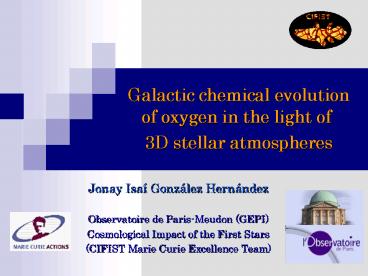Jonay Isa Gonzlez Hernndez - PowerPoint PPT Presentation
1 / 37
Title:
Jonay Isa Gonzlez Hernndez
Description:
Cosmological Impact of the First Stars (CIFIST Marie Curie Excellence Team)? Outline ... (CIFIST Marie Curie Excellence Team)? 3D Model: Metallicity dependence ... – PowerPoint PPT presentation
Number of Views:39
Avg rating:3.0/5.0
Title: Jonay Isa Gonzlez Hernndez
1
Galactic chemical evolution of oxygen in the
light of 3D stellar atmospheres
- Jonay Isaí González Hernández
- Observatoire de Paris-Meudon (GEPI)?
- Cosmological Impact of the First Stars
- (CIFIST Marie Curie Excellence Team)?
2
Outline
- Introduction
- Grid of 3D models
- Observations
- Analysis
- Preliminary results
- Conclussions
3
Oxygen
- The most abundant element
- after H and He
- Produced during
- hydrostatic and
- explosive
- nucleosynthesis
- in massive stars
Tominaga et al. (2007)?
4
Oxygen
- Its abundance is determined by
- - Forbidden lines OI 6300 and 6363 A
- - permitted near-IR triplet OI 7772-5 A
- - near-IR vibration-rotation bands
- - near-UV electronic transition bands
5
Oxygen in the Sun 3D
- Previous abundance determination
- log N(O)/N(H)128.66 (Asplund et al. 2005)?
- New abundance determination
- log N(O)/N(H)128.76 (Caffau et al. 2008)?
6
Oxygen problem OI
Cayrel et al. (2004)?
- Each O abundance indicator provides a
- different abundance trend O vs. Fe
- OI shows a quasi-plateau with
- O/Fe0.4-0.5 in subgiants and giants
- (García Pérez et al. 2006 Cayrel et al.
2004)? - in the metallicity range -1.5 lt Fe/H lt -3.5
- However, from OI, Nissen et al. (2002)
- showed a linear increase O/Fe vs Fe/H in
- dwarfs in the range -0.5 lt Fe/H lt -2.5
Nissen et al. (2002)?
García Pérez et al. (2006)?
7
Oxygen problem OI
- Near-IR OI triplet shows a linear steep
- increase O/Fe towards lower Fe/H
- (Israelian et al. 2001 Boesgaard et al 1999
- Nissen et al. 2002 Fulbright Johnson
- 2003) for dwarfs, subgiants and giants for
- -0.8 lt Fe/H lt -3.2
- Fulbright Johnson (2003) found a
- disagreement of 0.4 dex between OI triplet
- and OI
Israelian et al. (2001)?
8
Oxygen problem OH
- Near-UV OH shows also a linear steep
- increase of O/Fe towards lower Fe/H
- (Israelian et al. 2001 Boesgaard et al 1999)?
- for dwarfs with -0.8 lt Fe/H lt -3.4
- However, García Pérez et al. (2006) claimed
- a plateau of O/Fe0.5 for subgiants with
- -1.5 lt Fe/H lt -3.
García Pérez et al. (2006)?
9
Oxygen problem
- It is clear that this disagreement should
- be related to the limitations of the
- analysis employed
- The deviations from NLTE and the effects
- of granulation and temperature
- inhomogeneities (3D effects) may help
- to solve this discrepancy
10
Oxygen in metal-poor stars 1D
O/Fe
Fulbright Johnson (2003)?
Fe/H
11
Oxygen in metal-poor starsNLTE and 3D effects
- OI is not sensitive to NLTE effects but
- is slightly affected by 3D inhomogeneities
- OI triplet is significantly dependent on
- NLTE effects
- Near-UV OH are strongly sensitive to
- 3D effects and maybe slightly dependent
- on NLTE although in the opposite direction
12
Abundance trends Oxygen 3D
O/Fe
The most metal-poor spectroscopic binary dwarfs
CS22876-032 (Fe/H-3.7) González Hernández et
al. (2008)?
1D
dwarfs
3D
FeI/H
13
3D model atmospheres
- 3D atmospheric models
- are computed with
- CO5BOLD (Wedemeyer et
- al. 2003)?
- Representative selection of
- snapshots of the stellar
- photosphere
- Spectral synthesis code
- Linfor3D
14
Abundance corrections
- 3D - lt3Dgt corrections
- - lt3Dgt model temporal and
- horizontal average of the 3D model
- - Same micro-physics with vturb fixed
- 3D 1D corrections
- - Lagrangian hydrostatic 1D model
- - Same micro-physics with vturb fixed
15
Model Atmospheres 3D
3D
- 3D versus 1D
OH
1D
Fe
16
Model Atmospheres 3D
- 3D versus lt3Dgt
- lt3Dgt versus 1D
OH
Fe
17
3D model grid
18
3D Model gravity dependence
Fe/H-3
Teff5500 K
OH
Fe
19
3D Model Metallicity dependence
20
Observations
- Spectroscopy with VLT/UVES
- Spectral region 300.0-390.0 nm
- ?/d? 43,000
- S/N gt 100 at 312.0 nm
21
Stellar parameters
- Teff from IRFM using 2MASS JHKs
- log g from Hipparcos paralaxes
22
3D-1D abundance correctionTeff dependence
OH
23
3D-1D abundance correctionTeff dependence
Fe
24
3D-1D abundance correctionlog g dependence
OH
25
3D-1D abundance correctionexcitation potential
dependence
Fe
26
3D-1D abundance correctionexcitation potential
dependence
OH
27
1D O abundances
28
3D O abundances
29
Galactic oxygen evolution
Kobayashi et al. (2006)?
30
Conclusions and Future work
- 3D models appear necessary in order to determine
O abundances - from near-UV OH bands, mainly due to cooling
effects that - metal-poor 3D models show
- The abudance trend of O seems to show a
quasi-linear increase - towards lower metallicity or at least two
plateau, one at 0.5-0.6 - dex and the other at 0.9-1 dex at the lower
metallicities. - However, this might be considered with caution
until 3D - corrections and NLTE effects are applied to O
and Fe for different - abundance indicators in dwarfs, subgiants and
giants
31
Galactic chemical evolution of oxygen in the
light of 3D stellar atmospheres
- Jonay Isaí González Hernández
- Observatoire de Paris-Meudon (GEPI)?
- Cosmological Impact of the First Stars
- (CIFIST Marie Curie Excellence Team)?
32
3D Model Metallicity dependence
33
Chemical Analysis
- FeI and FeII abundances (6500K) 1D
FeI
FeII
FeI
FeII
34
Chemical Analysis
- FeI and FeII abundances (6500) lt3Dgt
FeI
FeII
FeI
FeII
35
Abundance trends Oxygen 1D
O/FeI
OH
dwarfs
3D
3D
FeI/H
36
Abundance trends Oxygen 3D
O/Fe
dwarfs
FeI/H
37
Abundance trends Oxygen 3D
O/Fe
OI
giants
subgiants
dwarfs
FeI/H































